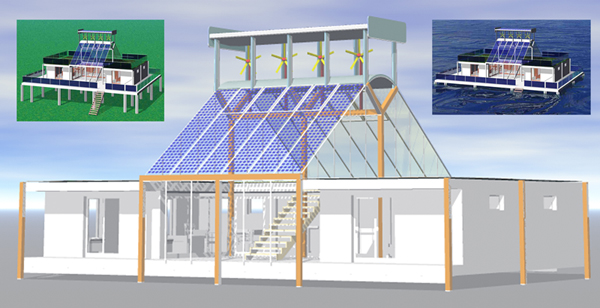Images of climate innovation
AeroSolar Dek House and Building System
Carbon emissions related to energy used in houses is considerable, and buildings likely account for ~40% of global carbon emissions. This project combines reduced energy demand strategies with innovative building-integrated renewable energy solutions to substantially reduce the carbon footprint of houses and related buildings. The building system also attempts to address challenges related to materials and components used, and the process of low impact building, later adaptation, and disassembly.

The AeroSolar Dek House™ and Building System project aims to explore a digital precision interlocking and demountable building system approach that combines ultra-levels of insulation, intrinsic thermal mass, super-glazing with capturing renewable energy flows via novel building-integrated renewable energy solutions.
These include the patented Aeolian Roof™ building-augmented wind and solar energy system (able to double the output of wind turbines). Plus, an integrated 2-storey Solar Atrium (clad with semi-transparent poly-generating solar glazing for clean electricity/space and water heating/cooling/ventilation/daylighting/solar-shading) together with technologies to utilise ambient, ground and/or water coupled and microbial energy flows.
The integration of thermal batteries/electric batteries plus in-situ hydrogen and fuel cell microCHP are also planned to improve resilience and extend the usability of renewables. Another integral component is for smart 2-way charging for EVs to further reduce emissions from personal transportation.
It is hoped to build a prototype Case Study House on the Open University campus to demonstrate the potential for such a building and to indicate how buildings can become net producers of clean renewable energy, and reduce and ultimately eliminate their carbon footprints.
If the Case Study House prototype performs well, it is hoped to replicate a further demountable AeroSolar Dek House used as a portable exhibition/demonstrator to show the potential for such a building approach. It would also be hoped to explore the viability of local digital micro factories/'flying factories' to begin to fabricate such buildings at scale and incorporate 'digital vernacular' local materials and components as appropriate.
An AeroSolar Regeneration-Retrofit variant could potentially apply this approach to existing buildings and if the AeroSolar Dek House is successful, it is hoped to explore the viability of integrating with a typical existing dwelling and to explore its potential to reduce the substantial carbon emissions from existing houses.
Entrant: Derek Taylor , The Open University
Copyright: Derek Taylor
Collaborators: Altechnica; Derek Taylor Eco-Architectural
Links
https://research.csiro.au/in-situ/
Researcher profile: https://www.strath.ac.uk/staff/robertsjendr/